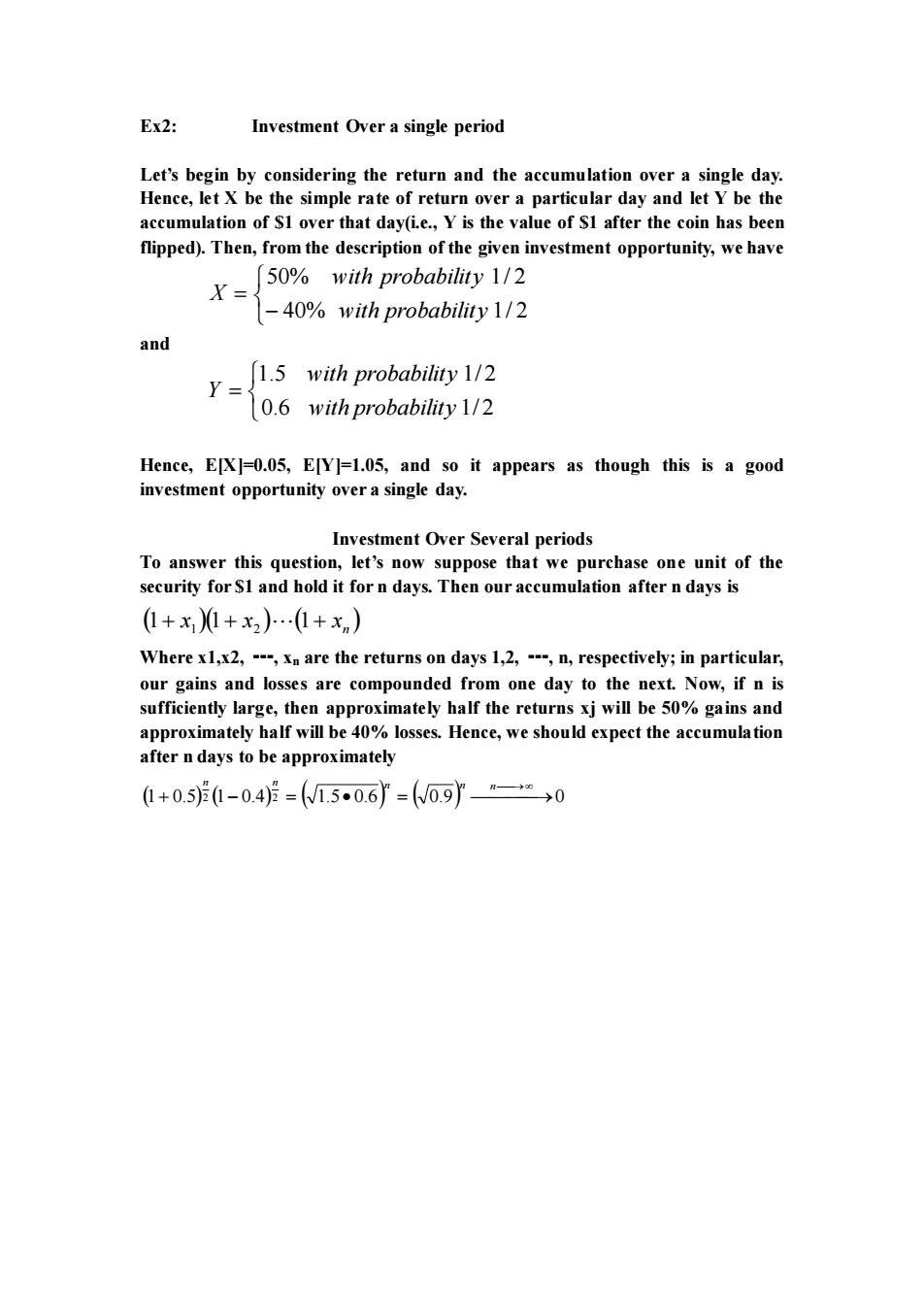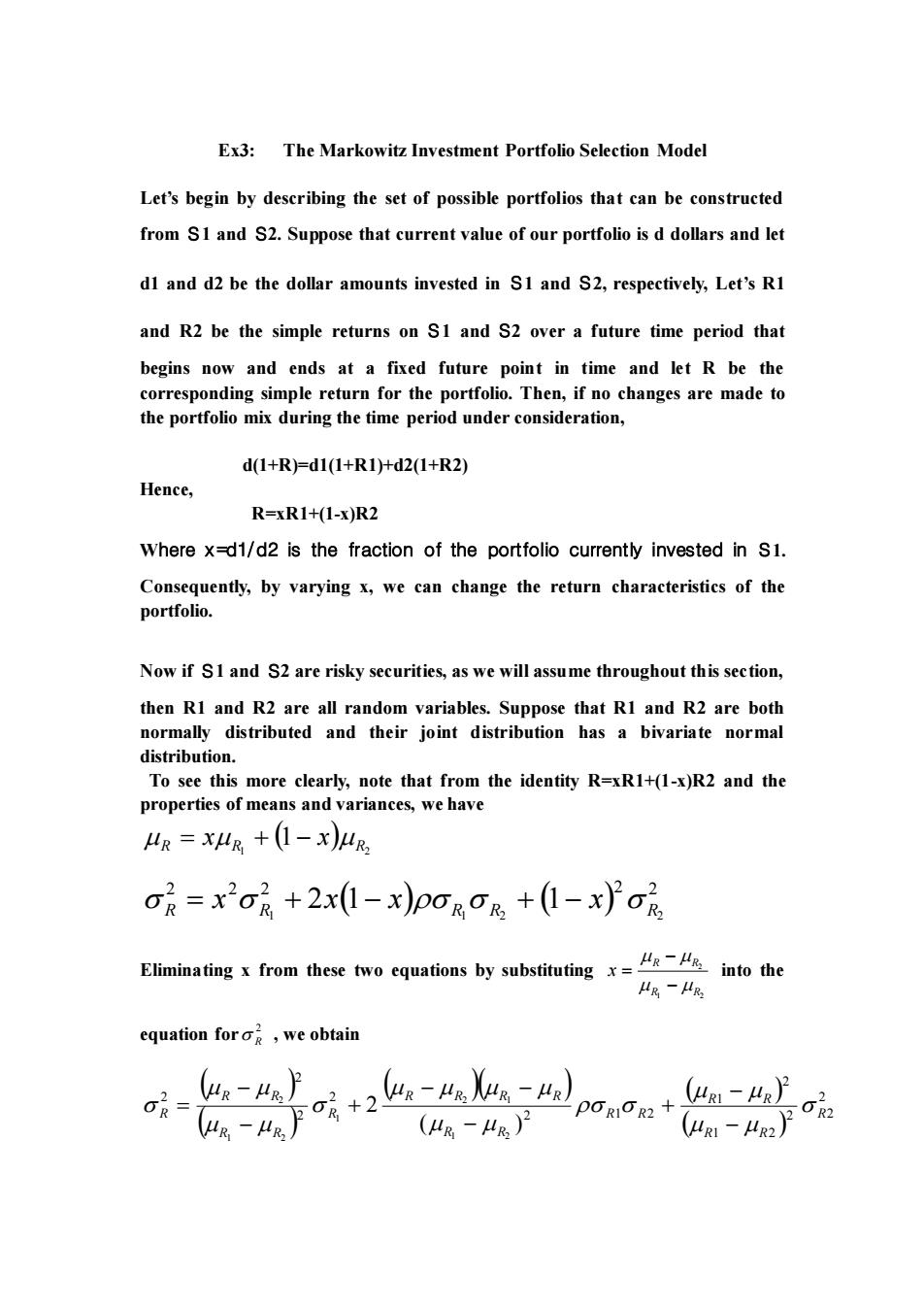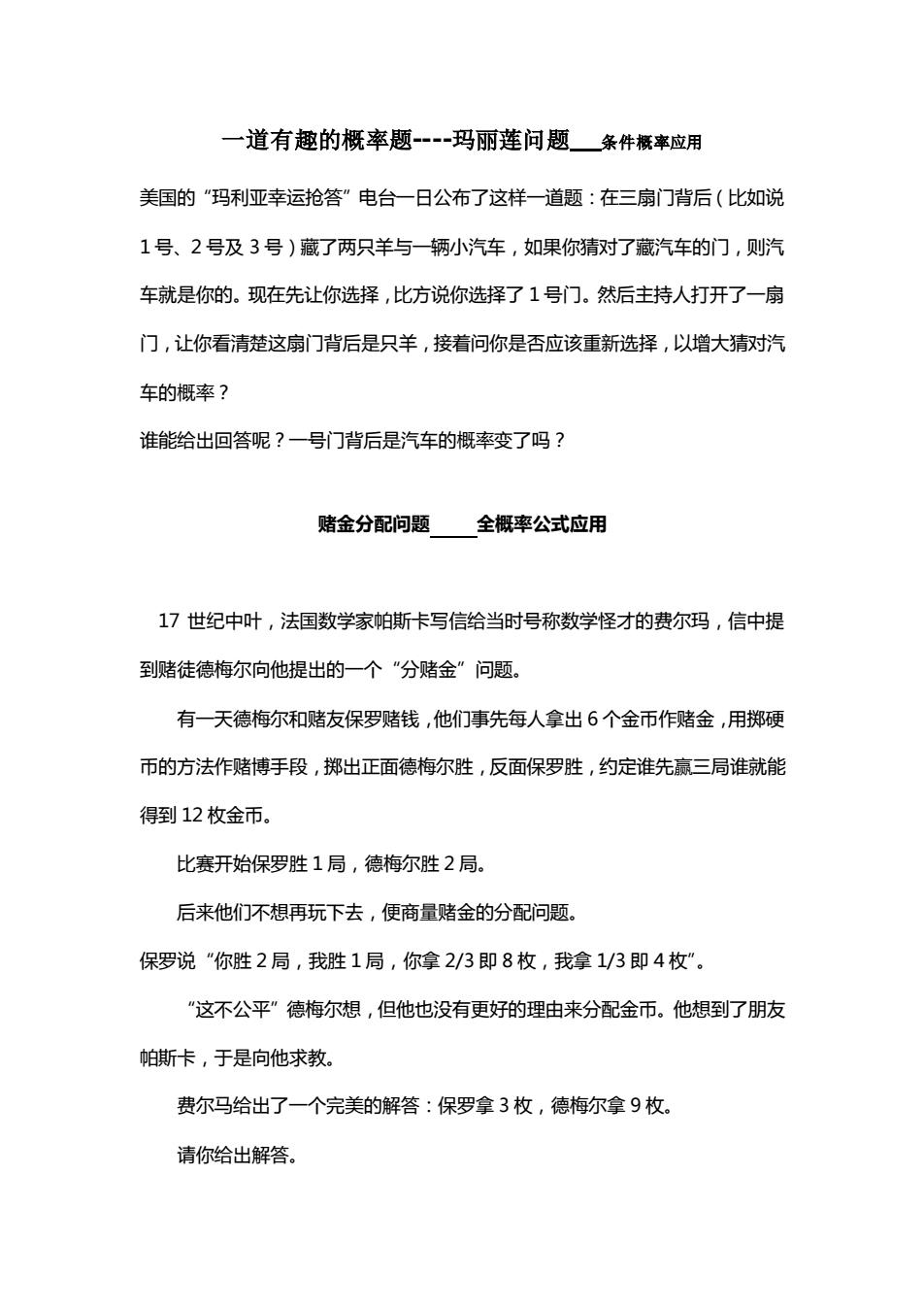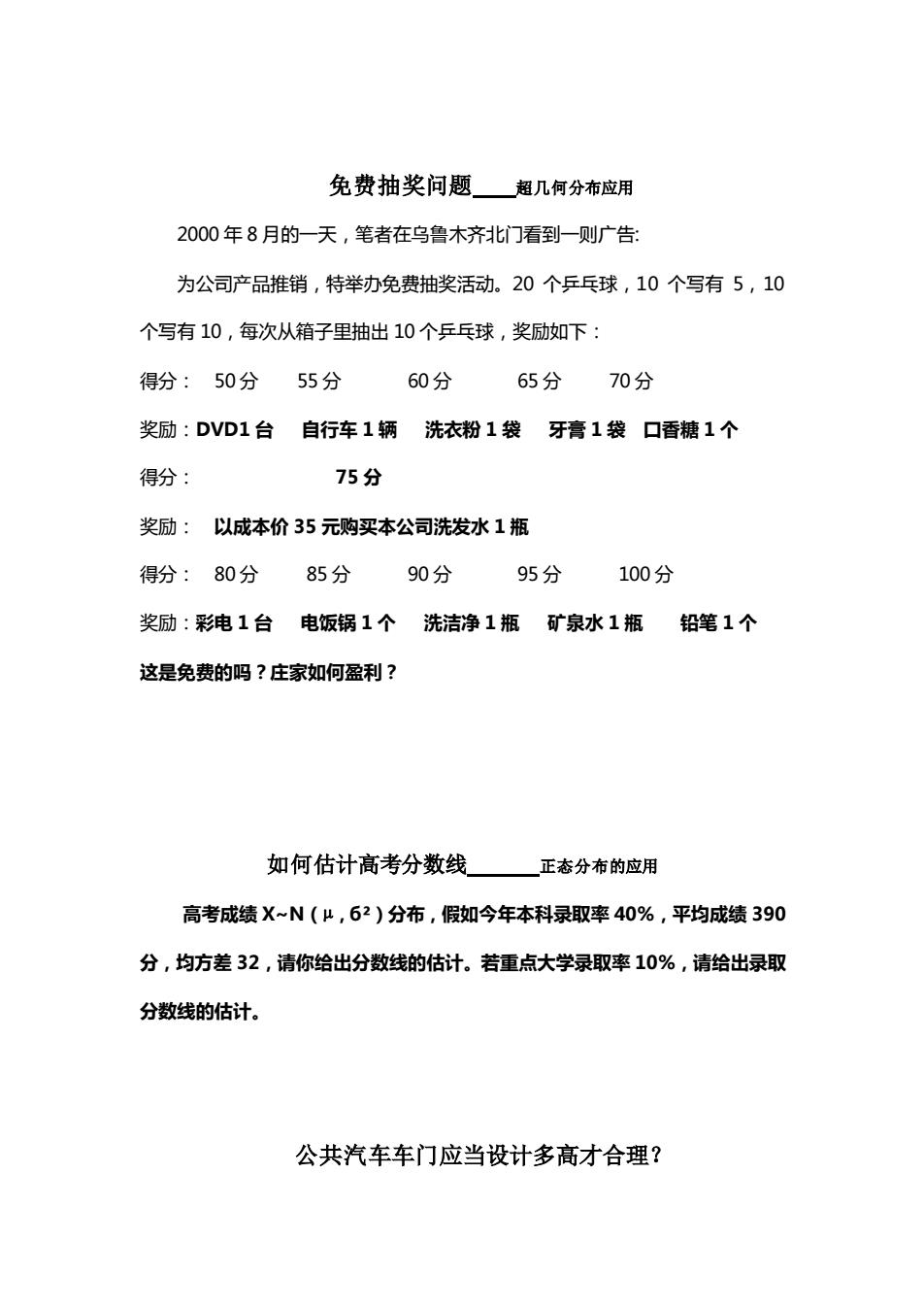
Probability The Science of Uncertainty with Applications to Investments, Insurance,and Engineering Exl:Two coins are tossed and the outcome is observed.Before the coins are tossed we are given a choice ofthe following payoffs Payoff 1: Vin S1 for each head」 Lose $3 for getting twotails Payoff2: Win$I if the coins are differen Win $2 if both coins tum up tails Lose $3 if both coins turn up heads. Which payoff should we choose? Y1(HH)=2,Y1(HT)-=1,Y1(TH)=1,Y1(TT)=-3 And Y2(HH)=-3,Y2(HT)=1,Y2(TH)=1,Y2(TT)=2 (1 fy=-3,2 /1 fy=-3,2 py (y)= if y=1 Pr (y)= if y=1 0 otherwise 20 otherwise Py (y)=py (y)for all y To address these questions,let's consider a third payoff: Payoff 3:Win $3 for getting two heads. Win $I for getting one of each Lose $4 for getting two tails. fy=-4,3 p,()= if y=1 0 otherwise E[YIJ=E[Y2J=E[Y3] That is,all three payoffs have the same expected value
Probability: The Science of Uncertainty with Applications to Investments, Insurance, and Engineering Ex1: Two coins are tossed and the outcome is observed. Before the coins are tossed, we are given a choice of the following payoffs: Payoff 1: Win $1 for each head. Lose $3 for getting two tails Payoff 2: Win $1 if the coins are different. Win $2 if both coins turn up tails. Lose $3 if both coins turn up heads. Which payoff should we choose? S={HH,HT,TH,TT} Y1(HH)=2, Y1(HT)=1, Y1(TH)=1, Y1(TT)= -3 And Y2(HH)=-3, Y2(HT)=1, Y2(TH)=1, Y2(TT)= 2 = = − = otherwise if y if y p y Y 0 1 2 1 3,2 4 1 ( ) 1 = = − = otherwise if y if y p y Y 0 1 2 1 3,2 4 1 ( ) 2 p y p y for all y Y Y ( ) ( ) 1 2 = To address these questions, let’s consider a third payoff: Payoff 3: Win $3 for getting two heads. Win $1 for getting one of each. Lose $4 for getting two tails. = = − = otherwise if y if y p y Y 0 1 2 1 4,3 4 1 ( ) 3 E[Y1]=E[Y2]=E[Y3] That is, all three payoffs have the same expected value

Ex2: Investment Over a single period Let's begin by considering the return and the accumulation over a single day. Hence,let X be the simple rate of return over a particular day and let Y be the accumulation of SI over that day(i.e.,Y is the value of SI after the coin has been flipped).Then,from the description of the given investment opportunity,we have 50%with probability 1/2 X= -40%with probability 1/2 and (1.5 with probability 1/2 Y= 0.6 with probability 1/2 Hence,E[X]=0.05,E[Y]=1.05,and so it appears as though this is a good investment opportunity over a single day. Investment Over Several periods To answer this question,let's now suppose that we purchase one unit of the security for SI and hold it for n days.Then our accumulation after n days is (1+x)1+x2).(1+xn) Wherex1,x2,are the returns on days 1,2,n,respectively;in particular. our gains and losses are compounded from one day to the next.Now,ifis sufficiently large,then approximately half the returns xj will be 50%gains and approximately half will be 40%losses.Hence,we should expect the accumulation after n days to be approximately 1+0.51-0.45=1.50.6=0.9"m→0
Ex2: Investment Over a single period Let’s begin by considering the return and the accumulation over a single day. Hence, let X be the simple rate of return over a particular day and let Y be the accumulation of $1 over that day(i.e., Y is the value of $1 after the coin has been flipped). Then, from the description of the given investment opportunity, we have − = 40% 1/ 2 50% 1/ 2 with probability with probability X and = 0.6 1/ 2 1.5 1/ 2 with probability with probability Y Hence, E[X]=0.05, E[Y]=1.05, and so it appears as though this is a good investment opportunity over a single day. Investment Over Several periods To answer this question, let’s now suppose that we purchase one unit of the security for $1 and hold it for n days. Then our accumulation after n days is ( )( ) ( ) n 1+ x 1+ x 1+ x 1 2 Where x1,x2, ┅, xn are the returns on days 1,2, ┅, n, respectively; in particular, our gains and losses are compounded from one day to the next. Now, if n is sufficiently large, then approximately half the returns xj will be 50% gains and approximately half will be 40% losses. Hence, we should expect the accumulation after n days to be approximately (1+ 0.5)2 (1− 0.4)2 = ( 1.5• 0.6) = ( 0.9) ⎯⎯ ⎯→0 n n n ⎯→ n n

Ex3:The Markowitz Investment Portfolio Selection Model Let's begin by describing the set of possible portfolios that can be constructed from SI and S2.Suppose that current value of our portfolio is d dollars and let dl and d2 be the dollar amounts invested in SI and S2,respectively,Let's RI and R2 be the simple returns on S1 and $2 over a future time period that begins now and ends at a fixed future point in time and let R be the d(1+RFd1(1+R1)+d2(1+R2) Hence, R=xR1+(I-x)R2 Where x=d1/d2 is the fraction of the portfolio currently invested in S1. Consequently,by varying x,we can change the return characteristics of the portfolio. Now if SI and S2 are risky securities,as we will assume throughout this section, then R1 and R2 are all random variables.Suppose that R1 and R2 are both normally distributed and their joint distribution has a bivariate normal distribution. To see this more clearly,note that from the identity R=xR1+(1-x)R2 and the properties of meansand variances.wehave 4R=x4R+(1-x4 oR=x2oR+2x(1-x)PORO+(1-x)oR Eliminating from these two cquations by substitutinginto the 4%-4% equation for,we obtain a-听+2c =44 PORIOR2 +4a-4} (山%-4R)尸 aa-Ae护8
Ex3: The Markowitz Investment Portfolio Selection Model Let’s begin by describing the set of possible portfolios that can be constructed from Ѕ1 and Ѕ2. Suppose that current value of our portfolio is d dollars and let d1 and d2 be the dollar amounts invested in Ѕ1 and Ѕ2, respectively, Let’s R1 and R2 be the simple returns on Ѕ1 and Ѕ2 over a future time period that begins now and ends at a fixed future point in time and let R be the corresponding simple return for the portfolio. Then, if no changes are made to the portfolio mix during the time period under consideration, d(1+R)=d1(1+R1)+d2(1+R2) Hence, R=xR1+(1-x)R2 Where x =d1/d2 is the fraction of the portfolio currently invested in Ѕ1. Consequently, by varying x, we can change the return characteristics of the portfolio. Now if Ѕ1 and Ѕ2 are risky securities, as we will assume throughout this section, then R1 and R2 are all random variables. Suppose that R1 and R2 are both normally distributed and their joint distribution has a bivariate normal distribution. To see this more clearly, note that from the identity R=xR1+(1-x)R2 and the properties of means and variances, we have ( ) 1 2 R R 1 R = x + − x ( ) ( ) 2 2 2 2 2 1 1 2 2 R R 2 1 R R 1 R = x + x − x + − x Eliminating x from these two equations by substituting 1 2 2 R R R R x − − = into the equation for 2 R , we obtain ( ) ( ) ( )( ) ( ) ( ) 2 2 2 1 2 2 1 2 1 2 2 2 2 2 ( ) 2 1 2 2 1 1 1 2 2 R R R R R R R R R R R R R R R R R R R − − + − − − + − − =

Which describes a curve in theplane as claimed G2=A(μ-4}+o Where -(n-oy-2m+)=Bon-+2-pn0 A 1 and oo-p2) —≥0 ORI-OR2)+2(1-P)R1OR2 Further =HaC -(m+e)Donon+n (oR1-O2P+20-P)bR10R2 Determining the optimal portfolio Now let's consider which portfolio in the efficient set is best.To do this we need to consider the investor's tolerance for risk. Let's consider one particular investor and let's suppose that this investor is able sign a number U(Fg)to each possible investment return distribution Fg with 1.U(FR)>U(Fgb)if and only if the investor prefers the investment with return Ra to the investment with return R. 2.U(Fga)=U(Fgp)if and only if the investor is indifferent to choosing between the investment with return Ra and the investment with return Rp U(Fg)=u-ka' Where k>0 is a number that measures the investor's level of risk aversion and aversion and is unique to each investor. Maximize:U(Fg)=u-ko? Subjeet to:2=Au+ Solution 1 。=4依+时 x=-4 L1-42
Which describes a curve in the R − R plane as claimed ( ) 2 0 2 0 2 = A − + Where ( ) ( 2 ) ( ) 2(1 ) 0 1 1 2 2 1 2 2 1 2 2 2 2 1 1 2 − + = − + − − = R R R R R R R R R R A B and ( ) ( ) ( ) 0 2 1 1 1 2 2 1 2 2 22 2 2 2 1 0 − + − − = R R R R R R Further ( ) ( ) ( ) 1 2 2 1 2 2 1 2 1 2 2 1 2 1 2 0 R R 2 1 R R R R R R R R R R − + − − + + = Determining the optimal portfolio Now let’s consider which portfolio in the efficient set is best. To do this we need to consider the investor’s tolerance for risk. Let’s consider one particular investor and let’s suppose that this investor is able to assign a number U(FR) to each possible investment return distribution FR with the following properties: 1. U(FRa)>U(FRb) if and only if the investor prefers the investment with return Ra to the investment with return Rb. 2. U(FRa)=U(FRb) if and only if the investor is indifferent to choosing between the investment with return Ra and the investment with return Rb. ( ) 2 U FR = − k Where k>0 is a number that measures the investor’s level of risk aversion and aversion and is unique to each investor. Maximize: ( ) 2 U FR = − k Subject to: ( ) 2 0 2 0 2 = A − + Solution 2 2 0 * 4 1 = + Ak 1 2 2 * R R R x − − =

一道有趣的概率题-玛丽莲问题条件概率应用 美国的“玛利亚幸运抢答”电台一日公布了这样一道题:在三扇门背后(比如说 1号、2号及3号)藏了两只羊与一辆小汽车,如果你猜对了藏汽车的门,则汽 车就是你的。现在先让你选择,比方说你选择了1号门。然后主持人打开了一扇 门,让你看清楚这扇门背后是只羊,接着问你是否应该重新选择,以增大猜对汽 车的概率? 谁能给出回答呢?一号门背后是汽车的概率变了吗? 赌金分配问题全概率公式应用 17世纪中叶,法国数学家帕斯卡写信给当时号称数学怪才的费尔玛,信中提 到赌徒德梅尔向他提出的一个“分赌金”问题。 有一天德梅尔和赌友保罗赌钱,他们事先每人拿出6个金币作赌金,用掷硬 币的方法作赌博手段,掷出正面德梅尔胜,反面保罗胜,约定谁先赢三局谁就能 得到12枚金币。 比赛开始保罗胜1局,德梅尔胜2局。 后来他们不想再玩下去,便商量赌金的分配问题。 保罗说“你胜2局,我胜1局,你拿2/3即8枚,我拿1/3即4枚”。 “这不公平”德梅尔想,但他也没有更好的理由来分配金币。他想到了朋友 帕斯卡,于是向他求教。 费尔马给出了一个完美的解答:保罗拿3枚,德梅尔拿9枚。 请你给出解答
一道有趣的概率题-玛丽莲问题 条件概率应用 美国的“玛利亚幸运抢答”电台一日公布了这样一道题:在三扇门背后(比如说 1 号、2 号及 3 号)藏了两只羊与一辆小汽车,如果你猜对了藏汽车的门,则汽 车就是你的。现在先让你选择,比方说你选择了 1 号门。然后主持人打开了一扇 门,让你看清楚这扇门背后是只羊,接着问你是否应该重新选择,以增大猜对汽 车的概率? 谁能给出回答呢?一号门背后是汽车的概率变了吗? 赌金分配问题 全概率公式应用 17 世纪中叶,法国数学家帕斯卡写信给当时号称数学怪才的费尔玛,信中提 到赌徒德梅尔向他提出的一个“分赌金”问题。 有一天德梅尔和赌友保罗赌钱,他们事先每人拿出 6 个金币作赌金,用掷硬 币的方法作赌博手段,掷出正面德梅尔胜,反面保罗胜,约定谁先赢三局谁就能 得到 12 枚金币。 比赛开始保罗胜 1 局,德梅尔胜 2 局。 后来他们不想再玩下去,便商量赌金的分配问题。 保罗说“你胜 2 局,我胜 1 局,你拿 2/3 即 8 枚,我拿 1/3 即 4 枚”。 “这不公平”德梅尔想,但他也没有更好的理由来分配金币。他想到了朋友 帕斯卡,于是向他求教。 费尔马给出了一个完美的解答:保罗拿 3 枚,德梅尔拿 9 枚。 请你给出解答

免费抽奖问题超几何分布应用 2000年8月的一天,笔者在乌鲁木齐北门看到一则广告 为公司产品推销,特举办免费抽奖活动。20个乒乓球,10个写有5,10 个写有10,每次从箱子里抽出10个乒乓球,奖励如下: 得分:50分55分60分65分70分 奖励:DVD1台自行车1辆洗衣粉1袋牙膏1袋口香糖1个 得分: 75分 奖励:以成本价35元购买本公司洗发水1瓶 得分:80分85分90分95分100分 奖励:彩电1台电饭锅1个洗洁净1瓶矿泉水1瓶铅笔1个 这是免费的吗?庄家如何盈利? 如何估计高考分数线正态分布的应用 高考成绩X~N(μ,62)分布,假如今年本科录取率40%,平均成绩390 分,均方差32,请你给出分数线的估计。若重点大学录取率10%,请给出录取 分数线的估计。 公共汽车车门应当设计多高才合理?
免费抽奖问题 超几何分布应用 2000 年 8 月的一天,笔者在乌鲁木齐北门看到一则广告: 为公司产品推销,特举办免费抽奖活动。20 个乒乓球,10 个写有 5,10 个写有 10,每次从箱子里抽出 10 个乒乓球,奖励如下: 得分: 50 分 55 分 60 分 65 分 70 分 奖励:DVD1 台 自行车 1 辆 洗衣粉 1 袋 牙膏 1 袋 口香糖 1 个 得分: 75 分 奖励: 以成本价 35 元购买本公司洗发水 1 瓶 得分: 80 分 85 分 90 分 95 分 100 分 奖励:彩电 1 台 电饭锅 1 个 洗洁净 1 瓶 矿泉水 1 瓶 铅笔 1 个 这是免费的吗?庄家如何盈利? 如何估计高考分数线 正态分布的应用 高考成绩 X~N(µ,б²)分布,假如今年本科录取率 40%,平均成绩 390 分,均方差 32,请你给出分数线的估计。若重点大学录取率 10%,请给出录取 分数线的估计。 公共汽车车门应当设计多高才合理?

建模并解答,最好有调查数据
建模并解答,最好有调查数据